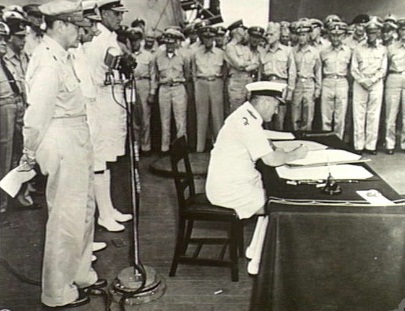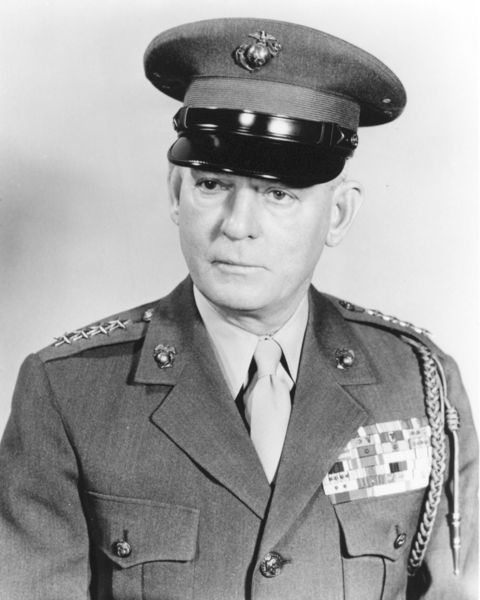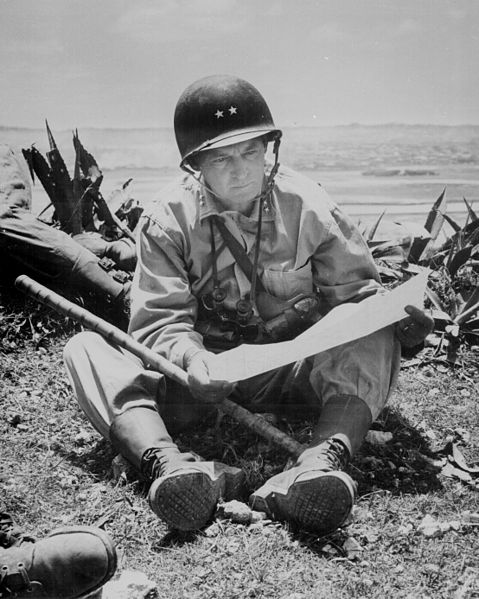<Back to Index>
- Commander of the Royal Pacific Fleet Admiral of the Fleet Bruce Austin Fraser, 1888
- Commandant of the 6th Division of the United States Marine Corps General Lemuel Cornick Shepherd, Jr., 1896
PAGE SPONSOR

Admiral of the Fleet Bruce Austin Fraser, 1st Baron Fraser of North Cape GCB, KBE (5 February 1888 – 12 February 1981) was a senior British admiral during World War II.
Fraser joined the Royal Navy as a Cadet on 15 January 1904. He rapidly marked himself out as a young man who had the potential to go far in the service and achieved first class passes in all his Sub - Lieutenant's exams, which he took between March 1907 and December 1908. He was promoted Sub - Lieutenant on 15 March 1907 and Lieutenant on 15 March 1908. His time in these ranks was mainly spent in the Channel and Mediterranean Fleets. He returned to the Home Fleet in August 1910 and remained there serving in HMS Boadicea until the end of July the following year. On 31 July 1911 Fraser joined HMS Excellent, the Royal Navy's school of Gunnery at Whale Island in Portsmouth harbor where he commenced the 'long course' to qualify as a specialist Gunnery Lieutenant. Promotions to Lieutenant Commander followed in March 1916, Commander in June 1919 and Captain in June 1926.
Fraser served in the cruiser HMS Minerva in the Dardanelles and East Indies and then in the battleship HMS Resolution during World War I. After the war he was captured and imprisoned by Bolsheviks in Russia in 1919 but released in 1920. He then served in the Naval Ordnance Department from 1922 before becoming a Fleet Gunnery Officer and then Head of the Tactical Section of the Naval Staff in 1927. He was appointed to command the cruiser HMS Effingham in 1930 and then became Director of the Naval Ordnance Department in 1933.
He returned to sea in command of the aircraft carrier HMS Glorious in 1936 and then became Chief Staff Officer to the Flag Officer Aircraft Carriers in 1936. He reached Flag rank as a Rear Admiral in January 1938 and was made Chief of Staff to the Commander - in - Chief Mediterranean Fleet in 1939. In May 1940 he was promoted Vice Admiral.
At the outset of the War Fraser was appointed Third Sea Lord and Controller of the Navy. In 1942 as a Vice Admiral he was made Second - in - Command, Home Fleet and Flag Officer, 2nd Battle Squadron. Fraser was appointed Commander - in - Chief of the Home Fleet with the acting rank of Admiral in May 1943, a rank that was confirmed in February 1944.
During that period he commanded the Royal Navy force that destroyed the Scharnhorst at the Battle of North Cape on December 26, 1943. Units of the Home Fleet regularly escorted convoys to Murmansk in the Soviet Union. Fraser was convinced that Scharnhorst would attempt an attack on Convoy JW 55B, and put to sea in his flagship HMS Duke of York to reach a position between the convoy and the German battleship's base in North Norway. During the afternoon before the battle Fraser was described by one of his officers: "He wore no naval uniform as such, he just wore old trousers and a polo neck shirt and sweater and a rather battered admiral's hat, with his pipe belching sparks and flame. He moved among us all . . it was a real triumph of a single personality dominating a ship's company". Thus Fraser avenged the destruction by Scharnhorst in 1940 of his old command, HMS Glorious.
Following his command of the Home Fleet, he went east in the summer of 1944 to take command firstly of the Eastern Fleet in 1944 and then of the powerful British Pacific Fleet later that year. Unlike his time in command of the Home Fleet this was not a seagoing command. He commanded from ashore in Australia. The BPF took part in the assault on Okinawa and the final strikes on the Japanese home islands.
Fraser was the British signatory to the Japanese Instrument of Surrender at Tokyo Bay on 2 September 1945.
In 1946 Fraser was raised to the peerage as Baron Fraser of North Cape, of Molesey in the County of Surrey. Following the war he became Commander - in - Chief, Portsmouth, in 1947 and then First Sea Lord and Chief of the Naval Staff in 1948. He retired in 1951 with the rank of Admiral of the Fleet. Lord Fraser of North Cape died in February 1981, aged 93, when the barony became extinct.


Lemuel Cornick Shepherd, Jr. (February 10, 1896 – August 6, 1990) was a four star general of the United States Marine Corps. A veteran of World War I, World War II, and the Korean War, he was the 20th Commandant of the Marine Corps. As Commandant, he secured a place on the Joint Chiefs of Staff, gaining parity for the Marine Corps with the other military services.
Lemuel Cornick Shepherd Jr. was born February 10, 1896 in Norfolk, Virginia. He graduated from the Virginia Military Institute in 1917, graduating a year early so he could enter the Marine Corps. While at VMI, Shepherd became a member of the Beta Chapter of Kappa Alpha Order. He was commissioned a second lieutenant in the Marine Corps on April 11, 1917 and reported for active duty at the Marine Barracks, Port Royal, South Carolina, on May 19, 1917.
Less than a year after reporting for duty, 2nd Lt. Shepherd sailed for France as a member of the 5th Marine Regiment with the first elements of the American Expeditionary Forces. He served in defensive sectors in the vicinity of Verdun and participated in the Aisne - Marne offensive (Château - Thierry) where he was twice wounded in action at Belleau Wood during the fighting there in June 1918. He returned to the front in August, rejoining the 5th Marines and saw action in the St. Mihiel and Meuse - Argonne offensives (Champagne) where he was wounded for the third time, shot through the neck by a machine gun.
For his gallantry in action at Belleau Wood, Lieutenant Shepherd was awarded the Army Distinguished Service Cross, the Navy Cross, the French Croix de guerre, and was cited in the general orders of the 2nd Infantry Division, American Expeditionary Forces.
After duty with the Army of Occupation in Germany, Capt. Shepherd
sailed for home in July 1919. In September 1919 he returned to France.
His assignment was to prepare relief maps showing the battlefields over
which the US 4th Marine Brigade had fought.
Shepherd returned to the States in December 1920, and was assigned as White House aide and Aide - de - Camp to the Commandant of the Marine Corps, Major General John A. Lejeune.
In July 1922, he took command of a selected company of Marines at the Brazil's Centennial Exposition in Rio de Janeiro.
In June 1923, Shepherd was ordered to sea duty as Commanding Officer of the Marine Detachment on the USS Idaho (BB-24). This tour was followed by duty at the Marine Barracks, Norfolk, where he commanded the Sea School. In April 1927, Shepherd sailed for expeditionary duty in China, where he served in the 3rd Marine Brigade in Tientsin and Shanghai.
Shepherd returned to the United States in 1929, and entered the Naval War College at Newport, Rhode Island. Following graduation in May 1937, he commanded the 2nd Battalion, 5th Marine Regiment, part of the newly formed Fleet Marine Force (FMF), Atlantic, which was being extensively employed in the development of amphibious tactics and techniques.
In June 1939, he was ordered to the Staff of Marine Corps Schools, Quantico, Virginia,
where he served during the next three years as Director, Correspondence
School; Chief of the Tactical Section; Officer in Charge of the
Candidates Class; and Assistant Commandant.
In March 1942, four months after the United States entry into World War II, Colonel Shepherd took command of the 9th Marine Regiment. He organized, trained, and took the unit overseas as part of the 3rd Marine Division.
Upon promotion to Brigadier general in July 1943, he served on Guadalcanal. Brigadier General Shepherd was assigned as Assistant Division Commander of the 1st Marine Division. In this capacity, he participated in the Cape Gloucester operation on New Britain from December 1943 through March 1944, where he was awarded a Legion of Merit for distinguished service in command of operations in the Borgan Bay area.
In May 1944, Shepherd assumed command of the 1st Provisional Marine Brigade and led them in the invasion and subsequent recapture of Guam during July and August 1944. For distinguished leadership in this operation, Shepherd received his first Distinguished Service Medal and was promoted to Major General.
After organizing the 6th Marine Division from the Brigade, Shepherd commanded it throughout the Battle of Okinawa and subsequently took the Division to Tsingtao,
China. There, October 25, 1945, he received the surrender of the
Japanese forces in this area. For exceptionally meritorious service as
Commanding General of the 6th Marine Division in the assault and
occupation of Okinawa (April 1 to June 21, 1945) he was awarded a Gold
Star in lieu of a second Distinguished Service Medal.
Several months later, Shepherd returned to the United States and in March 1946, organized the Troop Training Command, Amphibious Forces, Atlantic Fleet, at NAB Little Creek, Virginia. On November 1 of the same year, he was ordered to duty as Assistant to the Commandant Marine Corps Headquarters. He remained at this post until April 1948, when he was assigned to Quantico where he served as Commandant of the Marine Corps Schools until June 1950.
When the Korean War erupted, Shepherd was in command of the Fleet Marine Force (FMF), Pacific, with Headquarters at Pearl Harbor. In this capacity, he played a major role in the amphibious assault at Inchon and the evacuation of U.S. forces from Hungnam following their withdrawal from the Chosin Reservoir in North Korea in December 1950. On January 1, 1952, President Harry S. Truman appointed Shepherd Commandant of the Marine Corps (CMC).
During
Shepherd's four year appointment as the Commandant of the Marine Corps,
he initiated a number of important policies that resulted in increased
military proficiency for the Corps. He was the first Commandant to
become a member of the Joint Chiefs of Staff, and upon his retirement on January 1, 1956, he was awarded a third Distinguished Service Medal.
Two months after his retirement, Shepherd was recalled to active duty and appointed Chairman of the Inter - American Defense Board. During his three and a half years of service with this international organization, Shepherd, through his leadership and diplomacy, made substantial contributions towards plans for the defense of the continent. He also promoted military solidarity among the military forces of the republics of the Western Hemisphere. He relinquished his duties with the Inter - American Defense Board on September 15, 1959.
Shepherd died on August 6, 1990 at his home in La Jolla, California, from bone cancer. He was buried with full military honors at Arlington National Cemetery.